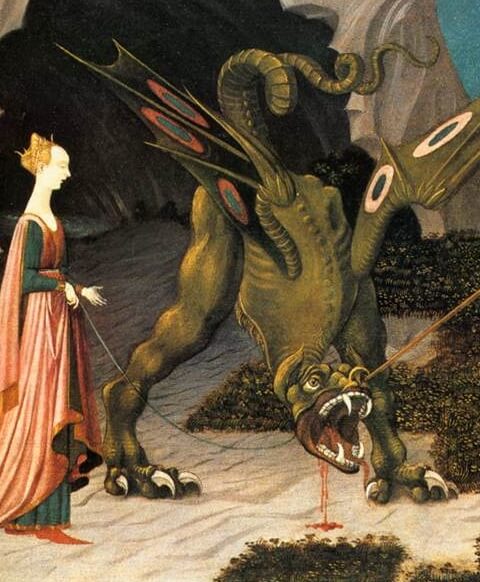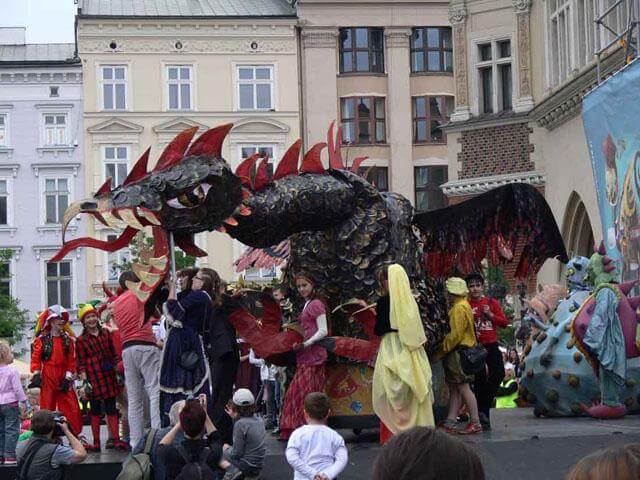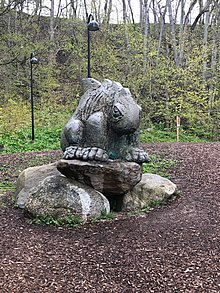So since last week’s podcast episode filled up with dragons from the Balkan region alone, and Eastern Europe is slightly larger than that, I thought we’d have a look at the dragons inhabiting the Baltic region.
But first, a closer look at the region itself: the Baltics is a geopolitical term most often used to encompass the three nations along the eastern coast of the Baltic Sea: Estonia, Latvia, and Lithuania. However, this term is not quite accurate when discussing culture, folklore, national identity or language. While the majority of people in Latvia and Lithuania are of Baltic descent, the same does not apply to Estonia, where the majority is of Finnic descent.
Christianity entered the picture in the fourteenth to fifteenth century, later than in the rest of Europe. Now, this is bound to have some influence on any recorded folklore, as we’ve seen in other regions. No native texts survived that christianisation. The earliest chronicles to date are those of missionaries trying to eradicate the indigenous paganism of the Baltic tribes, meaning that once again we have to account for some liberties taken with the source material of those ancient scribes.
For starters, the belief that sorcerers and witches are evil: while we’re fairly familiar with this concept as it’s been poured into us through almost every childhood fairytale, this is very much a Christian belief. Before that, the people of the Baltic tribes believed that, like everyone else, practitioners of magic could be either good or evil.
Lends a whole new meaning to the historical term before Christ, doesn’t it?
At any rate, the Baltic region has seen a lot of cross-pollination outside of Christianity as well, so digging through those layers and down to the original beliefs is a bit tricky. Still, it also lends folklorists and anthropologists another angle with which to reconstruct some of the old beliefs the inhabitants of the region held. Russian and German chronicles can offer some insights, by way of comparative mythology.
But that’s enough theoreticals. Let’s go and find some dragons.
Latvia

One thing I’ve been able to confirm from different sources, is that Latvians don’t consider dragons to be divine in nature. Rather, they see the dragon–or the pūķis as they call it–as not too intelligent. The role they play is somewhat reminiscent of a witch’s familiar, but with a touch of kleptomania thrown in. They would steal grain and other riches and bring them to their master.
So, an easy scapegoat for when a prosperous neighbour is more successful than you, maybe?
Naturally, someone fortunate enough to have gained the trust and companionship of such a nifty dragon would treat it like the treasure it is. Who wouldn’t? The pūķis received the first bit of every meal. According to one account, if they felt they were not sufficiently revered and appreciated, they’d turn on their master and burn their house down.
So OK, I want one of these. Seriously. My very own dragon? They wouldn’t even have to bring me riches, and it would be well and truly worshipped. I promise. But how would I recognise one when I come across it? Since no one but its master could lay eyes on these dragons, they were kept in a separate room with a sturdy lock. If the wrong person walked in and saw the pūķis, it would flee and the bereaved master would have to go back to finding or making their own riches.
Reports vary on the appearance of these creatures. Some describe it as a flying serpent, sometimes a bird. But sometimes, it was a flying ball of fire. I think we may have found ourselves another shapeshifter. That particular trait would certainly come in handy to acquire or steal treasures for one’s master. The ball of fire theory was also a highly convenient way for Latvians to explain the appearance of meteorites. Those were simply pūķis either in search of some treasure or on their way back to deliver it to their masters.
Lithuania

The Aitvaras, much like its Latvian cousin, is a nature spirit, and it has the same dubious habits as well. Where the pūķis attaches itself to a master who then needs to care for it and keep it hidden, the aitvarai tend to attach themselves to people’s houses and refuse to leave. They will bring the inhabitants grains and other goodies, but again, these will be stolen as often as not. Things have to come from somewhere, right? However, these stolen goods, when in the form of recognisable items such as, I don’t know, jewelry, or perhaps fine silverware, tend to get the household in trouble with their neighbours.
Also similar to the pūķis is the association of the aitvarai with meteors. We do have a bit more detail on the appearance of these creatures, and I have to say, it’s making my fingers itch to write a story about them.
An aitvaras resembles a black, golden, or white rooster with a fiery tail, and they hatch from the egg of a rooster aged between nine and fifteen. Did anyone say cockatrice? In some cases, the aitvaras is also attributed with shapeshifting abilities, appearing as a bird indoors and a fire-breathing dragon outdoors. Other incarnations also include a small grass snake with a tail that becomes luminescent when the snake is flying, a huge snake with a flaming head, or even made entirely out of fire.
And the most gorgeous and poignant detail ever? When an aitvaras dies, it becomes a spark.
Estonia
So, considering the somewhat different cultural pedigree of Estonia, we’d expect our dragons to be a rather different creature than the mischievous, kleptomaniac family pets, right? Right.
Dragons seem a wee bit harder to pin down here, and I couldn’t find that much detail. One thing, however, is certain. Once again, we’re left with a slight aftertaste of Christianity.
First of all, I found descriptions of an aiatar, also known as ajatar. This malevolent spirit lives in the forests of Estonia and Finland, as well as on the tundra. The aiatar is a highly potent disease spirit. Luckily, she was banished by Christianity. Aren’t we all supremely grateful? (Spoiler: I, for one, am not.)
She–because of course like the ultimate evil serpent from the Bible, she is female–has retreated to desolate areas where good christians are less likely to bother her. If they do get lost and venture too close to her, it’s believed that she spreads illness as a sort of man repellant. A defense mechanism to safeguard her solitude.
She too is a shapeshifter, appearing as a dragon, a snake, or a woman suckling snakes.

Äijö, one of the names of this fascinating creature, is sometimes also used as an alternative name for Ukko, the supreme god in the Finnish pantheon who shares a good number of traits with Thor. However, he is most often referred to by the name Äijö when he is portrayed as the Devil in post-christian times. One other source also mentioned the possibility that Aiatar might have been Ukko’s mother.
One other dragon I found with a connection to Estonia actually inhabits a fairy tale: The Dragon of the North. Dr. Friedrich Kreutzwald, an Estonian writer and sometimes referred to as the father of Estonian national literature, recorded it in Eestirahwa Ennemuistesed jutud. Later, Andrew Lang included it in The Yellow Fairy Book after he encountered the original in a German translation of Kreutzwald’s book. Personally, I’m quite partial to the Estonian title, which translates as Frog of the North, or Northern Frog.

“The frog’s body was completely covered in armor, stronger than stone and iron, so nothing could hurt him. His two great eyes shone night and day like the lighter candles, and whoever saw their light in an unfortunate manner once, it was as if done and had to go into his mouth as bait.” (Excerpt from the story)
I mean, can you imagine a frog dragon? We’ve had fish, cat, and shark dragons, crocodiles, and whales. But this has got to be our first frog.
In the story, a dragon fled the northern cold. It ravaged the land, gorged itself on livestock, and burned the crops down to the very roots. It was said that there was only one way to stop it. One would have to use Solomon’s ring. So one brave young man (because it has to be one of those, right?) sets out on a quest. A magician tells him to seek help from the birds, and makes a potion that will help our hero to understand their language. Once the poor sod brings back the ring, the magician will then translate the inscription on the ring.
The birds tell him that only the witch-maiden can help and they tell him which spring he must visit at the exact time when the moon is full, in order to find her. Now, the maiden is offended at having her moonlight swim disrupted, but eventually, she forgives him and takes him home. The young man hears a voice warning him not to give her any of his blood, as one does. So when she asks him to marry her, he begs for some time to consider. She explains the ring’s power and promises to give it to in return for three drops of his blood. After a few days of playing hard to get, he accuses her of lying so she demonstrates the ring’s power and lets him try it.
The ring then gives him the power of invisibility, and so he escapes. The magician reads the inscription on the ring and gives our brave but sneaky hero instructions on how to defeat the dragon. When he does so, he gets to marry a princess by way of reward, as one does. But the witch-maiden is not amused, so she takes the form of a magical eagle, steals back the ring, and chains him in a cave. In the end, the magician steps in once more, finds our hero with more help from the birds, and all is well.
Now, while I’m somewhat disappointed at the lack of detail on this frog dragon, I had to just take a moment and digest this story and quiet my inner Gollum. Right now, it’s shrieking, “Sneaky hobbitsessss!” at me.
We’ve got… birds telling our hero how to defeat a dragon, a quest for a magical ring that grants the wearer invisibility, and a magician not only playing the role of mentor and interpreter of the ring’s inscription, but also saving our marooned hero after the climactic scene in the story, and a magical sentient eagle.
Can we safely assume that we found another region that inspired elements of Tolkien’s work?
But for now, I have to leave you with that, as I have the sudden urge to make story notes on frog dragons and aitvarai.
Until next time,
Later mythsters!
Sources
- https://en.wikipedia.org/wiki/Baltic_states
- https://en.wikipedia.org/wiki/Latvian_mythology#Beings_and_concepts
- https://www.deviantart.com/dysharmonnia/art/Latvian-dragon-546615121
- https://pantheon.org/articles/p/pukis.html
- https://www.raganukalnas.lt/en/sculptures/-aitvarai-a-magic-creatures-of-lithuanian-mythology-/67#:~:text=The%20Aitvaras%20is%20a%20Lithuanian,even%20as%20a%20human%20being.
- https://en.wikipedia.org/wiki/Lithuanian_mythology
- https://www.raganukalnas.lt/en/sculptures/-aitvarai-a-magic-creatures-of-lithuanian-mythology-/67#:~:text=The%20Aitvaras%20is%20a%20Lithuanian,even%20as%20a%20human%20being.
- https://en.wikipedia.org/wiki/Aitvaras
- https://occult-world.com/aitvaras/
- https://occult-world.com/aiatar/
- https://en.wikipedia.org/wiki/%C3%84ij%C3%B6
- https://www.blackdrago.com/species/aijo.htm
- https://en.wikipedia.org/wiki/The_Dragon_of_the_North

Be First to Comment